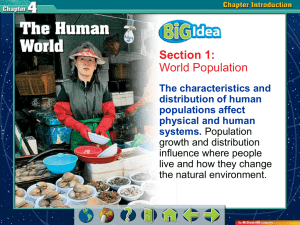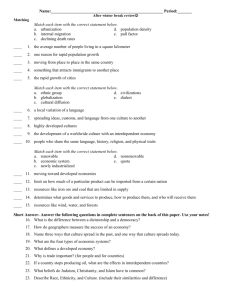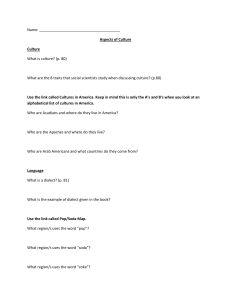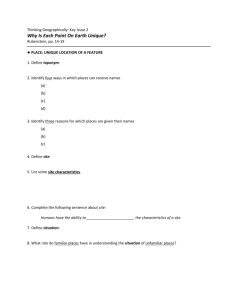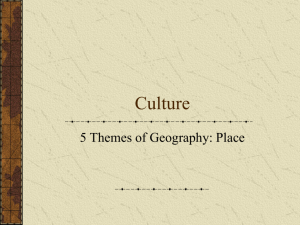Understanding Culture
advertisement
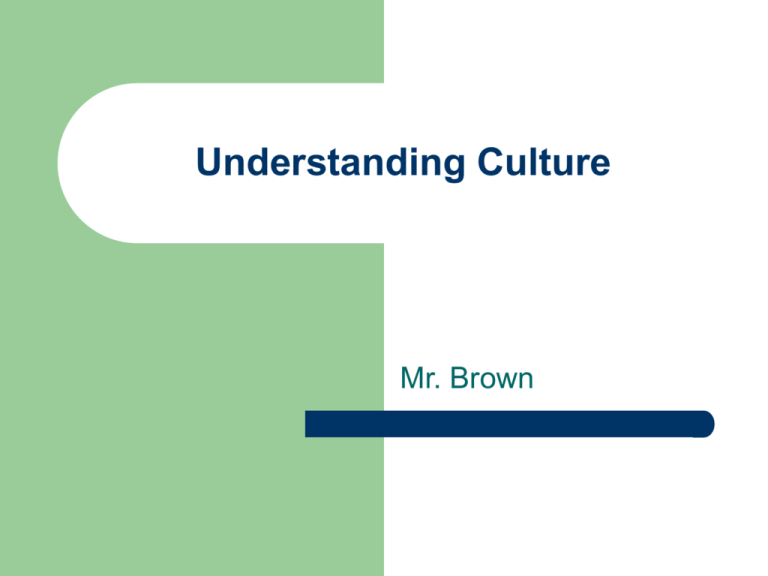
Understanding Culture Mr. Brown Today’s Agenda Warm-Up Activity Pass in Syllabus signed sheet Discuss Current Events Take notes on Culture Watch Video on Culture Notebooks 1. 2. 3. Current Events Notes in Class Edited Notes Daily Warm-Ups Warm-Up Day 2 Warm up 2 – Write a paragraph about how school has changed since leaving elementary school. Did You Know Culture is what makes you a stranger when you are away from home. For example, you might not know that Ukrainians enjoy chocolate-coated pork fat at Christmas time and that the Chinese have a special holiday, called Ching Ming, when they spend the day honoring deceased family members. I. What Is Culture? A. Culture is the way of life of a group of people who share similar beliefs and customs. B. When studying culture, geographers look at eight traits—social groups, language, religion, daily life, history, arts, government, and the economy. C. Among social groups, geographers study rich, poor, and middle class people. They may look at age or gender. They may study different ethnic groups, or people who share a common language, history, religion, and some physical characteristics. I. What Is Culture? D. Among people who speak the same language, one may hear a local form of a language, or dialect, that differs from the main language. E. In many cultures, religion helps people answer basic questions about life’s meaning. Religious beliefs vary greatly around the world and have resulted in conflicts and struggles based on religious differences. F. Daily life varies in different cultures. For example, the types of foods that people eat and the way they build their homes may vary. I. What Is Culture? G. History shapes how people view the world. Many cultures celebrate holidays that honor their heroes and heroines. A culture is influenced by how it remembers its successes and how it remembers its disasters and defeats. H. Culture is expressed through art, including painting, sculpture, architecture, dance, music, theater, and literature. Insight into a culture can be gained by studying what its people think is beautiful and important. I. What Is Culture? I. Types of government can reflect a country’s culture. A democracy is a form of limited government in which power rests with the people of a nation. In a representative democracy, such as the United States, citizens elect representatives. Some governments are led by individuals. In a dictatorship, dictators control and rule as they wish. In a monarchy, kings and queens inherit the power to rule. I. What Is Culture? J. In studying how the people of a culture earn a living, geographers study the culture’s economic system. This “system” sets rules for how people decide what goods and services to produce and how they are exchanged. How do the three main types of governments differ? In a democracy, power rests with the nation’s people. In a dictatorship, dictators rule as they wish with the help of the military. In a monarchy, the power to rule is inherited. II. Cultural Change A.The process of spreading new knowledge and skills to other cultures is called cultural diffusion. This happens as a result of trade, the movement of people, war, television, the Internet, and so on. B. As people learned to grow food, they tended to stay in one place and build settlements. This produced highly developed cultures, or civilizations. C. In the 1700s and 1800s, some countries began to industrialize and built factories to make goods, leading to the Industrial Revolution. D. More recently, the widespread use of computer technology has led to the Information Revolution. People around the world can instantaneously send and receive information. E. Geographers group the world’s countries into culture regions that have traits, or cultural characteristics, in common. What was the Information Revolution? Computers and the Internet made it possible to store and share huge amounts of information. This revolution connects the cultures of the world more closely than ever before. Agenda for August 20, 2010 Complete Warm-up Activity in notebook Take –up Current Event Notebooks Take notes on Population Take notes on population video Warm-Up Warm up 3 – Write a paragraph about what you remember about Hurricane Katrina? Did You Know During October 1999, world population reached 6 billion people, doubling in size in under 40 years. World population is still growing at a rate of 1.3 percent per year, with an average annual addition of 78 million people from 1999 to 2000. Population Growth A. The world’s population continues to grow. The death rate, or the number of people out of every 1,000 who die in a year, has gone down because of better health care and living conditions. Meanwhile, the birthrate, or the number of children born each year for every 1,000 people, is very high in some regions. B. Challenges from population growth include the rapid use of resources, a strain on a country’s economy, and the lack of food, or famine. What are reasons some experts are optimistic despite the high population growth? The levels of technology and creativity are increasing so that the growth can be managed. II. Where People Live A. The world’s population can only exist on a small fraction of the earth. This is due to the fact that only 30 percent of the earth is covered by land. Of that portion, half is uninhabitable because of ice, deserts, or high mountains. B. The world’s population is not distributed evenly. People prefer to live in places with plentiful water, good land, and a favorable climate. C. Population density is the average number of people living in a square mile or square kilometer. How do you calculate population density? Population density is the average number of people living in a square mile or square kilometer. To arrive at this figure, the total population is divided by the total land area. III. Population Movement A. Throughout the world, the population shifts as people move from place to place. B. Many people are leaving villages and farms and moving to cities. This movement is called urbanization. C. Nearly half the world’s people live in cities. The boundaries of cities and their suburbs keep expanding outward, a situation called urban sprawl. D. Some people emigrate, or leave the country in which they were born and move to another country. E. Some people flee to another country to escape persecution or disaster. These people are known as refugees. Why do some people emigrate? People emigrate to find jobs in the richer nations or to flee their country because of wars, food shortages, or other problems.
